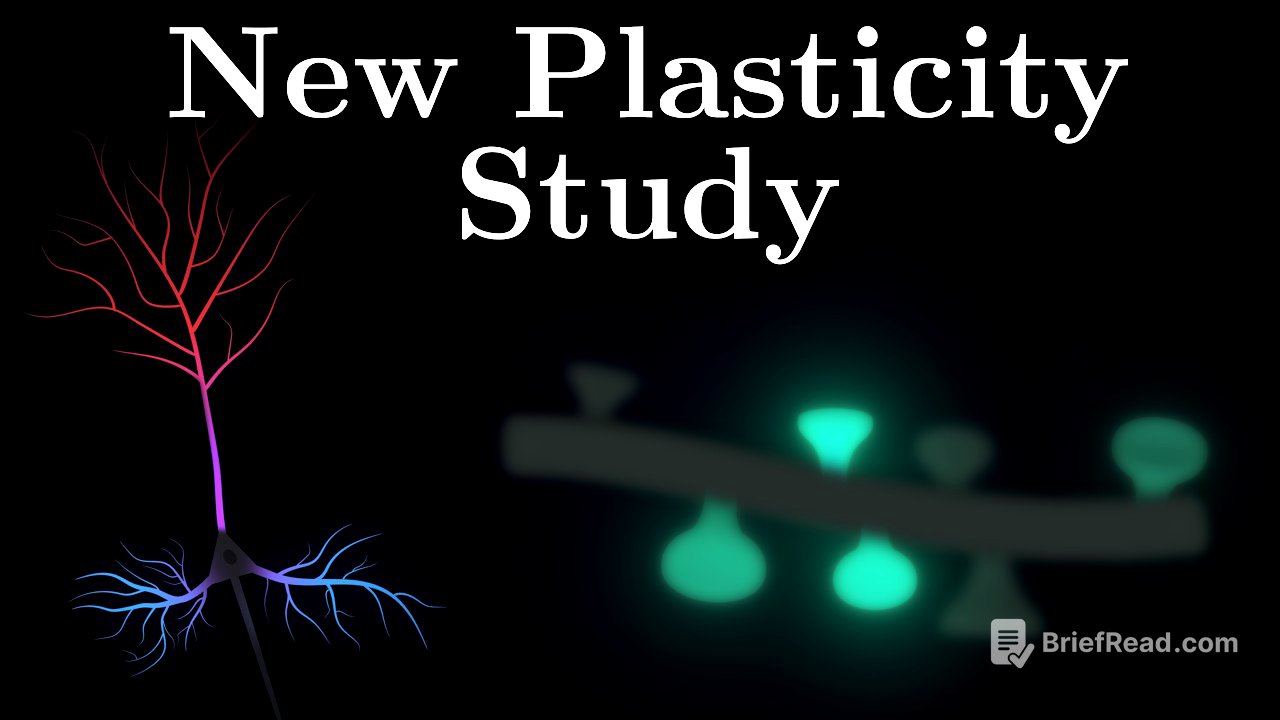TLDR;
This video explores the concept of synaptic plasticity, the brain's ability to rewire itself based on experiences. It discusses different plasticity mechanisms, focusing on a recent study that reveals how individual neurons use distinct plasticity rules for different synapses. The video covers Hebbian and non-Hebbian plasticity, the role of NMDA receptors, and how these mechanisms contribute to information processing in cortical neurons.
- Synaptic plasticity is the brain's ability to modify connections between neurons.
- Neurons use different plasticity rules for different synapses.
- Hebbian plasticity ("fire together, wire together") and non-Hebbian plasticity (local coactivity) are key mechanisms.
- A study on mice motor cortex reveals that apical and basal dendrites employ different plasticity rules.
Introduction [0:00]
The brain constantly rewires itself based on ongoing experiences through a process called synaptic plasticity. Understanding the principles behind this is a major goal in neuroscience. Recent advancements in experimental methods allow researchers to study synaptic plasticity in awake, behaving animals. Neurons use a variety of mechanisms for plasticity, and a recent study reveals that the same neuron uses different plasticity rules for different synapses. The video explores these different plasticity mechanisms, the methods used to uncover them, and what they might reveal about information processing in cortical neurons.
Synaptic transmission [1:23]
Computation in the brain is carried out by neurons, which are electrically excitable cells. Neurons collect electrical signals through dendrites, and if the signal is strong enough, the neuron fires an action potential (spike) that travels along the axon. When the electrical signal reaches the synapse, it is converted into chemical messengers called neurotransmitters. These neurotransmitters, such as glutamate, are released by the sending neuron and bind to receptors on the receiving neuron, triggering new electrical signals. Synaptic strength, which determines how much the receiving neuron's voltage changes in response to the sending neuron's spike, depends on factors like the number of receptor proteins on dendritic spines. Plasticity involves either growing or shrinking the spine and synapse, increasing or decreasing the effect on the post-synaptic membrane voltage. Long-term potentiation (LTP) refers to the strengthening of a synapse that lasts for a while.
Molecular machinery of LTP [6:09]
The NMDA receptor is a crucial molecule in synaptic changes, acting as a coincidence detector. When the presynaptic neuron spikes, it releases glutamate, which binds to AMPA and NMDA receptors on the receiving neuron's dendrite. AMPA receptors allow sodium ions to rush in, causing a small electrical excitation. NMDA receptors are blocked by a magnesium ion at the neuron's resting state. If the membrane of the receiving neuron becomes sufficiently depolarized, the magnesium is expelled, allowing calcium ions to flow in. Calcium initiates a cascade of molecular events, signaling the neuron to insert more receptors into the membrane and reorganize the cell's internal scaffolding, increasing the size of the dendritic spine.
Hebbian plasticity [8:40]
Significant NMDA receptor activation requires a stronger, more sustained depolarization. This can happen in two main ways, leading to Hebbian and non-Hebbian plasticity. Hebbian plasticity occurs when the postsynaptic neuron fires its own spike. If the receiving neuron gets enough excitatory input from different synapses, its cell body depolarizes enough to fire an action potential. This spike can spread backwards into the dendrites as a back-propagating action potential. If a presynaptic neuron releases glutamate while a back-propagating action potential sweeps through that part of the dendrite, the conditions for long-term potentiation are met. The glutamate ensures the NMDA receptor is primed, and the depolarization expels the magnesium block, allowing calcium to flood in. This pairing of presynaptic activity and postsynaptic spike embodies the "fire together wire together" principle.
Non-Hebbian plasticity [11:21]
Non-Hebbian plasticity can occur when several synapses close to each other on a dendritic branch become active around the same time. Their individual AMPA-mediated depolarizations can add up locally, pushing out the magnesium blocks from the NMDA receptors in that specific neighborhood, even if the neuron as a whole doesn't fire an action potential. This allows for highly specific, compartmentalized plasticity, where the neuron can strengthen a cluster of inputs on one dendritic branch independently of the rest of the neuron.
Hypothesis [12:51]
Researchers focused on pyramidal cells in the motor cortex of mice, which are key neurons involved in learning new movements. Pyramidal neurons have a main apical dendrite and bushier basal dendrites. The authors hypothesized that these distinct dendritic compartments might employ different plasticity rules. They suspected that plasticity in the basal dendrites might be more reliant on the classical Hebbian mechanism, while apical dendrites might use a non-Hebbian rule driven more by local coactivity between nearby synapses.
Experimental methods [14:42]
To study plasticity in a natural learning setting, researchers trained mice on a motor task where they had to press a lever beyond a certain point in response to an auditory cue to get a reward. During this learning process, they monitored the mouse brain using advanced imaging methods. They genetically modified neurons to express a glutamate-sensitive fluorescent reporter ("glue sniffer") to see synaptic input as flashes of green light. They also used a red glowing calcium indicator (RCAMP) to monitor the neuron's own activity, with large calcium signals indicating the neuron firing a spike. They took structural images of the same dendritic spines over consecutive days to quantify changes in spine size, identifying which synapses had undergone LTP.
Result: compartmentalized plasticity [17:10]
The researchers found that the rules for synaptic plasticity were strikingly different depending on whether they were looking at the apical or basal dendrites of the same neuron. Strengthening of synapses on apical dendrites was best predicted by local synaptic coactivity. An apical spine was more likely to grow if it and its immediate neighboring spines on the same branch were frequently active together. Whether or not the whole neuron fired an action potential did not seem to be the primary driver for plasticity. When the researchers blocked the neuron from firing action potentials, plasticity in apical dendrites was largely unaffected, showing that apical dendrites use a non-Hebbian, spike-independent mechanism for plasticity. In basal dendrites, the strengthening of synapses was best predicted by the classical Hebbian mechanism, the coincidence of synaptic input and the neuron's own action potentials. When the researchers blocked the neuron from firing action potentials, the ability of these basal synapses to undergo LTP was significantly diminished.
Interpretation [19:30]
The functional diversity within a single neuron might be important because apical and basal dendrites are wired up to receive different kinds of information. Apical dendrites receive feedback connections from higher-order cortical areas, carrying contextual information or predictions. Basal dendrites typically receive feedforward inputs, carrying the results of earlier computations or prediction errors. The anatomy of the pyramidal neuron with two distinct input zones might be the way the brain physically implements the computation for comparing predictions and reality. Non-Hebbian local co-activity at the apical branches might be useful for binding together different patterns of contextual input, while Hebbian mechanisms at basal dendrites might be crucial for strengthening the pathways that reliably drive the neuron to fire.
Brilliant [22:01]
Brilliant.org is a platform to master STEM topics online, offering courses with interactive visualizations and hands-on problem-solving. Their new course on digital circuits covers the fundamentals of computation from logic gates to truth tables and equivalent circuits. Brilliant offers courses in math, programming, and related fields.
Outro [23:08]
Share the video, subscribe to the channel, and press the like button for more neuroscience and machine learning topics.









